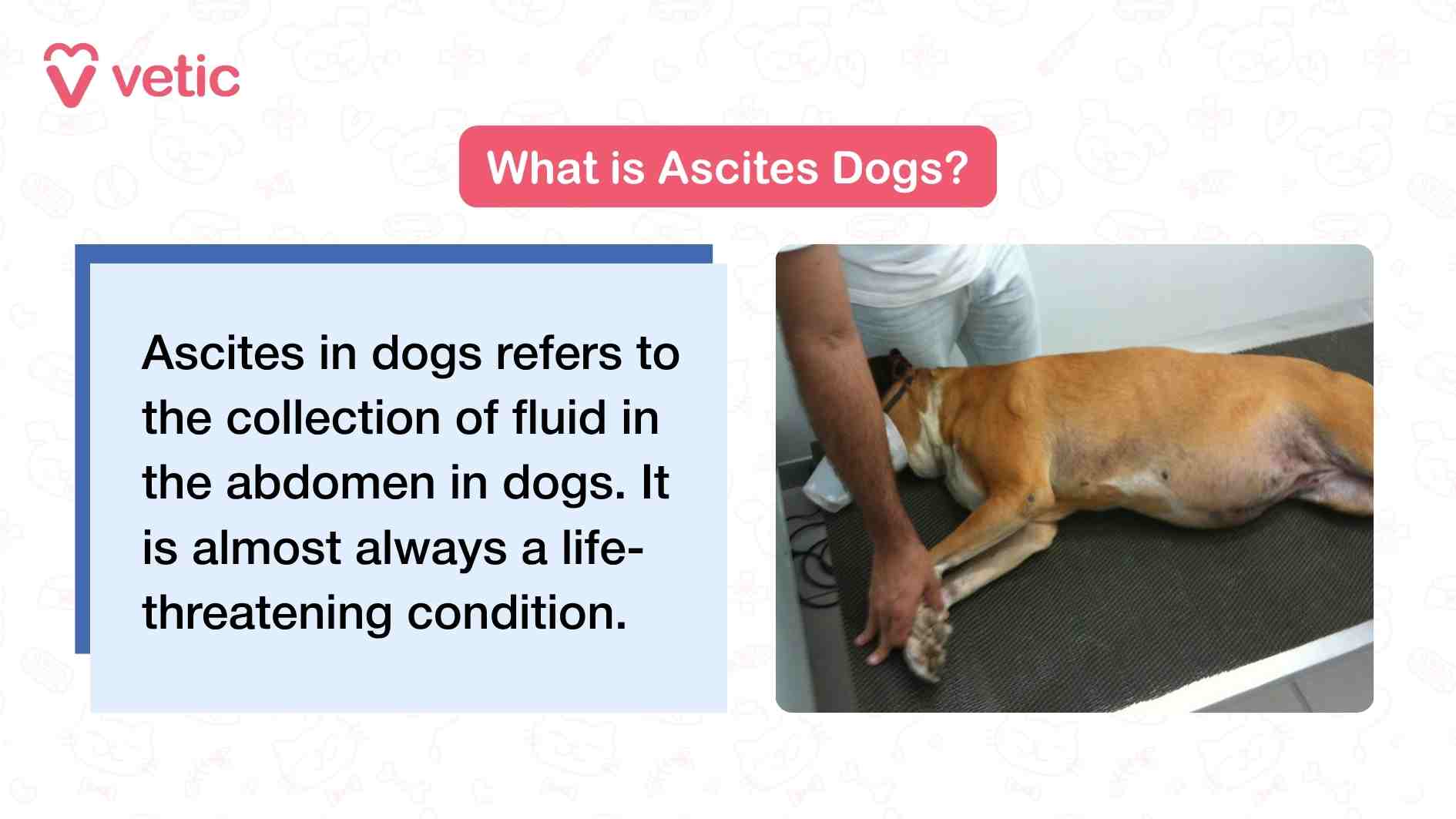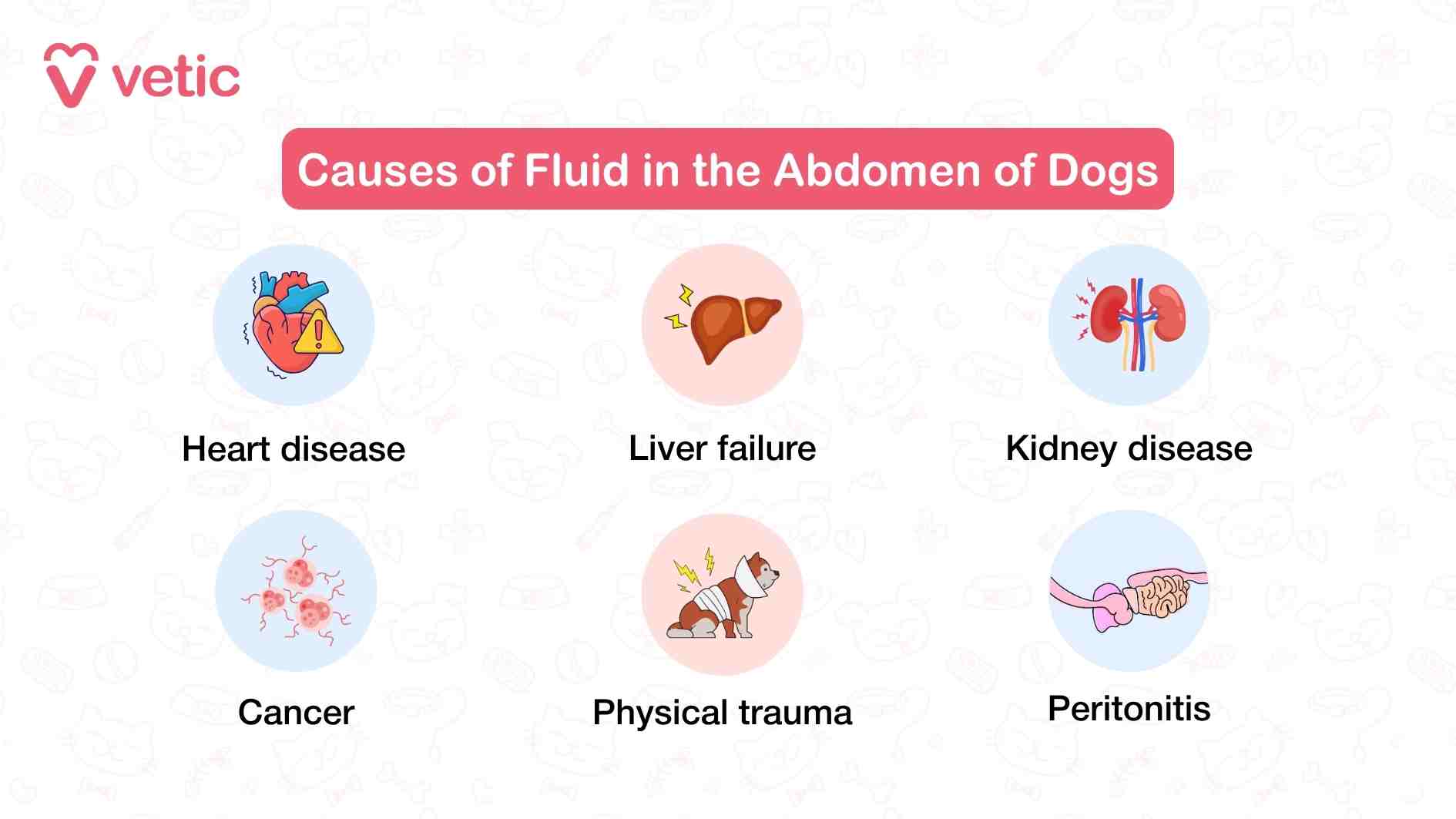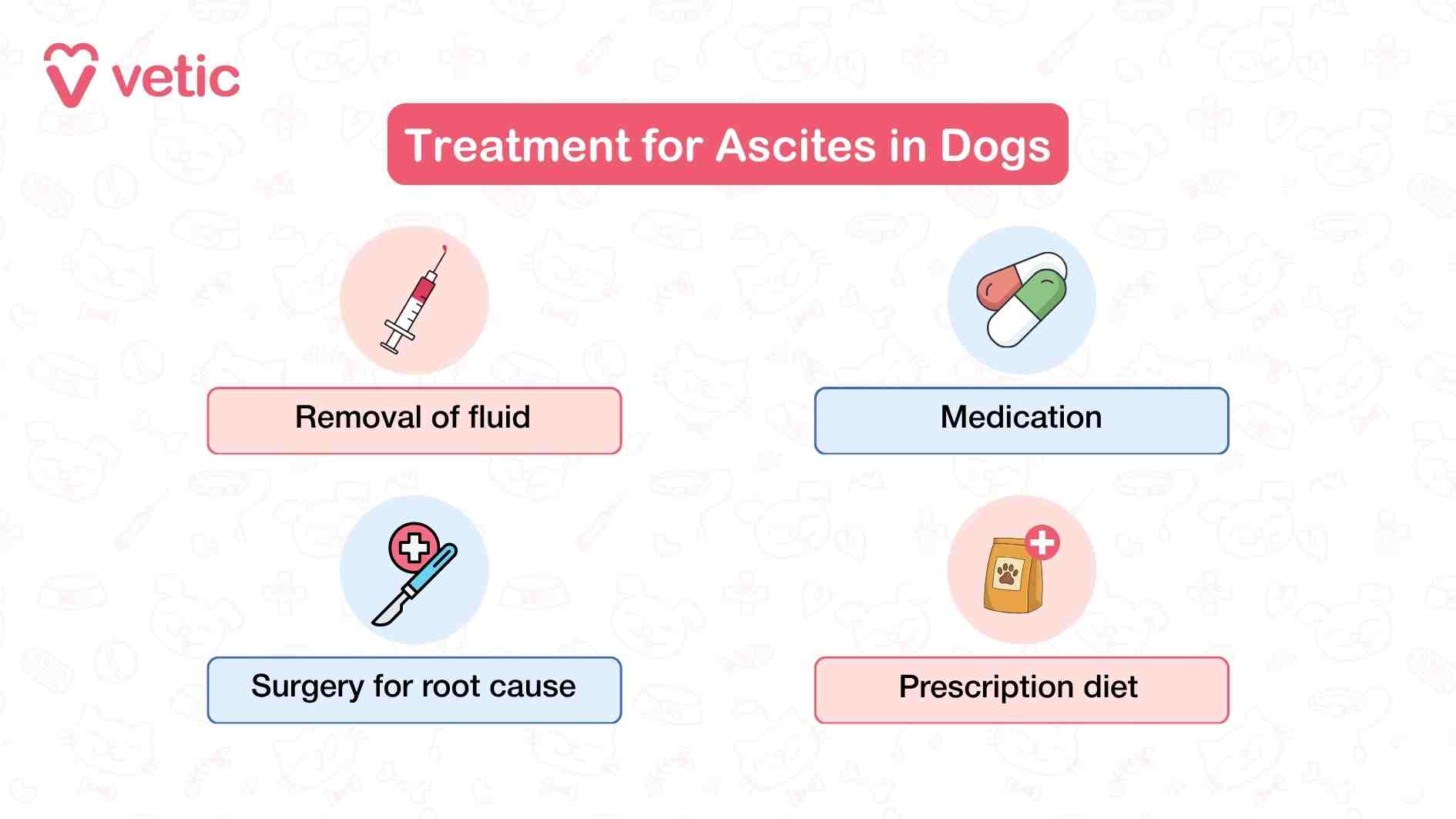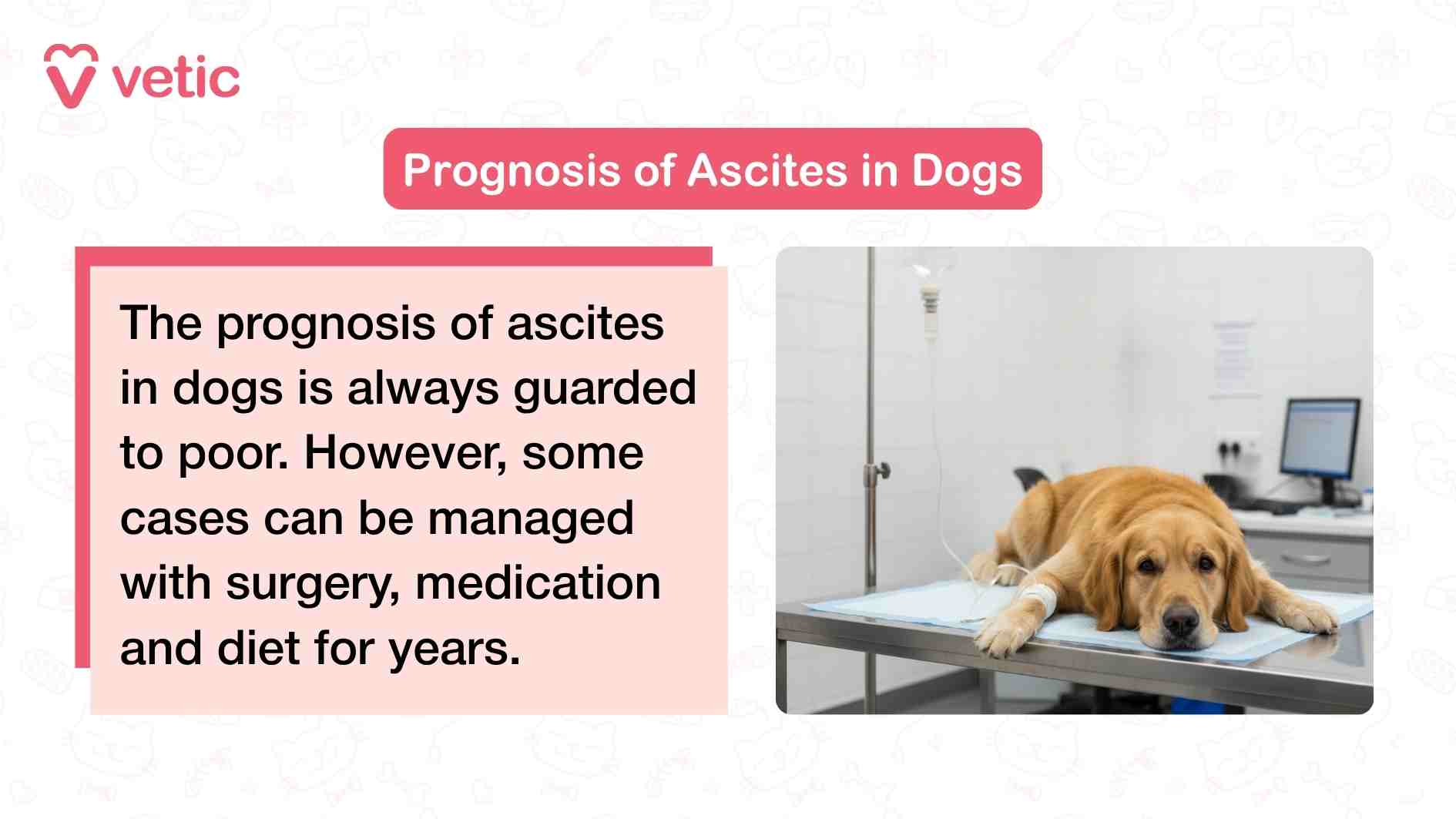When a dog’s belly suddenly looks swollen or feels tight, it’s often not just “bloating.” It could be fluid in the abdomen, also called ascites in dogs. This condition means fluid is collecting inside the abdominal cavity, pressing on vital organs and making your pet uncomfortable.
Ascites in dogs isn’t a disease by itself; it’s a sign that something serious is happening inside, such as liver disease, heart failure, infection, or cancer. Early diagnosis is crucial because fluid buildup is usually linked to a major underlying illness that needs immediate veterinary attention.
What Are the Signs of Fluid in the Abdomen of Dogs?

Common Visible Symptoms of Ascites
In most cases, the signs become noticeable only when a large amount of fluid has built up. You may observe:
- Swollen or distended belly that looks round or tight
- Difficulty breathing or heavy, rapid breathing
- Sudden weight gain without eating more
- Reduced activity and reluctance to move
- Vomiting or loss of appetite
Subtle Symptoms of Ascites
Early signs can be easy to miss. These may include:
- Decreased appetite or energy
- Pale gums or mild weakness
- Occasional coughing or restlessness
- Mild abdominal discomfort on touch
If you notice these changes, it’s important to visit your veterinarian immediately before the fluid puts further pressure on internal organs.
What Causes Accumulation of Fluid in the Abdomen of Dogs?
Ascites in dogs can result from many underlying health problems, most of them serious. Here are the common causes:

Heart Disease can Cause Fluid Accumulation
Conditions such as right-sided congestive heart failure or dilated cardiomyopathy can increase pressure in blood vessels, causing fluid to leak into the abdomen. Heartworm disease can have similar effects by damaging the heart and lung vessels.
Liver Disease or Failure Leading to Ascites
Chronic liver conditions like hepatitis or cirrhosis interfere with blood flow through the liver, leading to fluid leakage. Dogs with liver failure often show yellow eyes, poor appetite, and swollen abdomens.
Kidney Disease Can Cause Ascites
When the kidneys fail to retain enough protein in the blood, fluid can escape from blood vessels and collect inside the abdomen, a condition called protein-losing nephropathy.
Cancer and Tumors Lead to Fluid Accumulation
Cancers such as lymphoma or abdominal tumors can block lymphatic flow or rupture internal organs, leading to bleeding or fluid accumulation.
Infections and Peritonitis
Bacterial infections of the abdominal lining (peritonitis) can cause inflammation and fluid buildup. This is often accompanied by fever and severe pain.
Trauma or Injury Causes Ascites in Dogs
Car accidents, falls, or blunt injuries may rupture internal organs like the bladder, spleen, or liver. This leads to leakage of urine (uroabdomen) or blood (haemoabdomen) into the abdominal space.
Toxins or Poisoning
Certain poisons, such as rat poison, prevent normal blood clotting, causing internal bleeding and fluid buildup inside the abdomen.
How is the Presence of Fluid in the Abdomen of Dogs Diagnosed?
When your vet suspects fluid in your dog’s abdomen, they will perform a thorough physical exam followed by diagnostic tests.
Imaging Tests
X-rays and ultrasounds are commonly used to confirm the presence of fluid and assess the size and position of internal organs.
Abdominocentesis (Fluid Sampling)
In this procedure, the vet removes a small amount of fluid using a sterile needle. The sample is analyzed to check whether it’s blood, pus, lymph, or another fluid type, helping to identify the underlying cause.
Blood and Urine Tests
Tests like liver and kidney panels, complete blood count, and urinalysis give clues about organ function and help your vet diagnose heart, liver, or kidney issues.
What’s the Treatment for Ascites in Dogs?
Treatment depends on what’s causing the fluid buildup. The main goal is to reduce pressure in the abdomen and address the root disease.

Fluid Removal (Abdominocentesis)
Your vet may drain some of the fluid to relieve pressure on the lungs and organs. However, this is a temporary measure—it doesn’t cure the underlying problem.
Surgery for Underlying Conditions
If the cause is trauma, a ruptured organ, or a tumor, surgery may be needed to stop internal bleeding or repair damaged tissue.
Medications and Diuretics
Drugs like furosemide (a diuretic) help the body flush out extra fluid through urine. Heart medications may also be prescribed to improve circulation and reduce future fluid accumulation.
Prescription and Low-Sodium Diet
A low-sodium, prescription diet helps prevent further fluid retention. Dogs with chronic heart, liver, or kidney issues benefit from long-term dietary management recommended by the vet.
Prognosis and Recovery for Dogs with Ascites
The outlook for a dog with fluid in the abdomen depends entirely on the primary cause.
- If ascites is due to heart or liver disease, long-term treatment can help manage symptoms.
- If caused by cancer or severe infection, the prognosis is often guarded to poor.
Home care and regular vet visits play a big role in recovery. Keep your dog comfortable, monitor for breathing trouble, and follow all prescribed medications and dietary guidelines closely.
Can Ascites in Dogs Be Cured?
Ascites can often be managed but not completely cured, especially when linked to chronic diseases. However, early detection and consistent veterinary care improve the chances of long-term stability.
Routine Vet Check-ups
Senior dogs or breeds prone to liver and heart disease should undergo regular check-ups and imaging to catch issues early.
Early Screening for At-Risk Breeds
Breeds like Cocker Spaniels, Boxers, and Dobermans are more prone to heart and liver diseases—making early testing important.
Managing Underlying Diseases
Strictly follow your vet’s plan for managing conditions like hepatitis, heart failure, or kidney disease to prevent recurrence of fluid buildup.
Conclusion on Fluid in the Abdomen of Dogs
Fluid in the abdomen of dogs is a serious warning sign that should never be ignored. If you notice a swollen belly, labored breathing, or loss of appetite, seek veterinary attention right away.
At Vetic, our experienced veterinarians use advanced diagnostics and personalized care to identify the cause and help your dog recover comfortably. Book your consultation today and let us help your furry friend feel better, faster.
FAQs on Fluid in the Abdomen of Dogs
What is ascites in dogs?
It’s the buildup of fluid inside a dog’s abdomen, often due to liver, heart, or kidney disease.
How long can a dog live with fluid in the abdomen?
It depends on the cause—dogs can live months to years with proper treatment and care.
What are the common signs of fluid in a dog’s stomach?
Swollen belly, breathing difficulty, loss of appetite, and reduced energy.
Can ascites in dogs go away on its own?
No. It always needs veterinary diagnosis and treatment.
Is fluid drainage safe for dogs?
Yes, when done by a vet. It relieves pressure but doesn’t cure the underlying cause.
How can I prevent fluid buildup in my dog’s abdomen?
Routine vet visits, heartworm prevention, and early disease management help reduce the risk.


